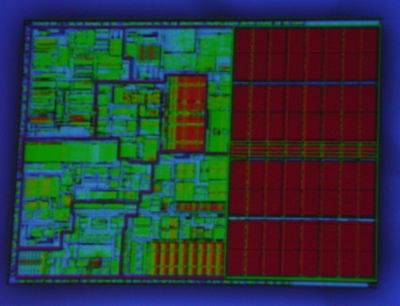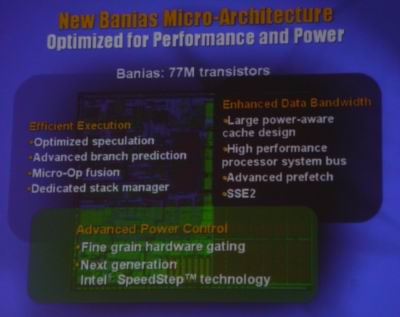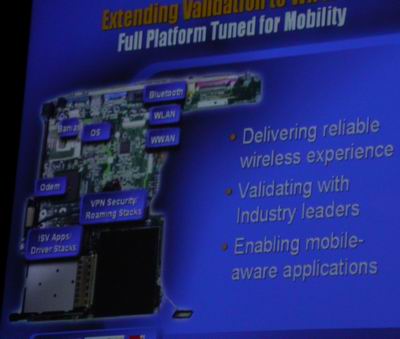
Original Link: https://www.anandtech.com/show/989
Intel Developer Forum Fall 2002 - Day 2: Banias Galore
by Anand Lal Shimpi on September 10, 2002 2:12 PM EST- Posted in
- Trade Shows
Bright and early this morning we began the second day of the Intel Developer Forum. Historically, the conference has gotten better as the week progresses and this fall IDF is no exception to the rule.
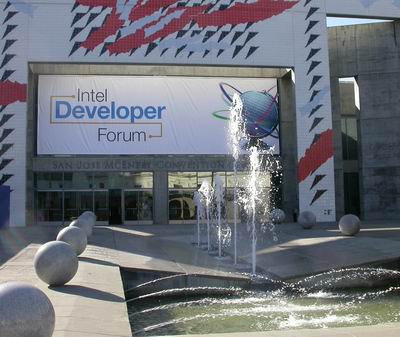
While the keynote started off on a slow note, it quickly turned into what we were used to from past IDFs. There were a number of demonstrations on what you can do with current wireless and Ethernet technology which we’ve already seen a number of times. Anand Chandrasekher then took the stage and discussed the platform we wanted to know most about at this IDF – Banias.
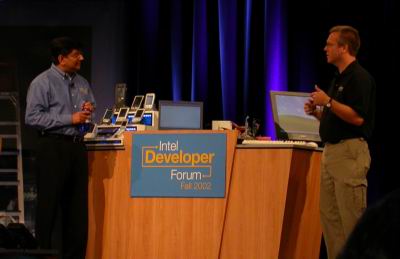
Anand (not me ;)...) didn’t hold back and provided some interesting information about Intel’s next-generation mobile CPU that we weren’t previously aware of.
The 0.13-micron Banias processor weighs in at 77 million transistors; you’ll note that this is a higher transistor count than the current 0.13-micron Northwood Pentium 4 processor. By far the biggest consumer of transistors is cache and thus we would expect Banias to have a fairly large L2 cache, probably around 1MB. We confirmed that the architecture is basically Pentium III derived with the addition of the features mentioned below.
You can also see a large portion of the die reserved for cache in the shot above.
Another slide provided a list of the following as features of the Banias architecture:
- Optimized Speculation
- Advanced Branch Prediction
- Micro-Op Fusion
- Dedicated Stack Manager
- Advanced Power Control (through granular hardware gating & enhanced speedstep technology)
Although there weren’t many details provided about these features, we did manage to get some clarity:
The Banias FSB is much more power optimized than any current Intel FSB; power management is achieved through turning off parts of the FSB that aren’t being used. When we talk about “turning off” a part of the FSB we’re really talking about turning off some of the power consuming buffers (memory) when they’re not in use.
We’ve already talked about Micro-Op Fusion, a feature that sends decoded instructions down the pipeline in bundles to improve efficiency. Another benefit of Micro-Op Fusion is reduced power usage because of a more efficient use of the pipeline. The Micro-Ops are only separated directly before being sent to the execution units.
Banias’ dedicated stack manager is another power saving tool integrated into the Banias architecture that is designed to manage stack pointers and other stack-related data. Remember that stacks are used to store information about the current state of the CPU including data that cannot be kept in registers due to limits in the number of available registers, thus a dedicated manager can help performance considerably. As usual, whenever efficiency is improved power consumption is optimized which is the case with Banias here as well.
Intel didn’t give much in terms of performance information on Banias however they did give us some clues to its positioning. Even after its release in the first half of next year, the Pentium 4-M will continue to exist alongside the Banias processor. The two processors will make up the two CPU market segments in the mobile market – Intel likes to call them the portability and mobility segments.

The Pentium 4-M reference heat exchanger
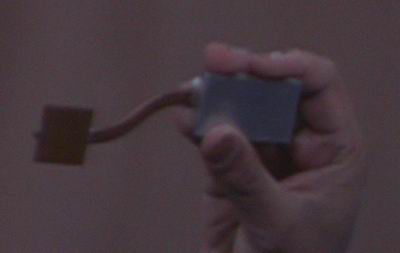
The Banias reference heat exchanger
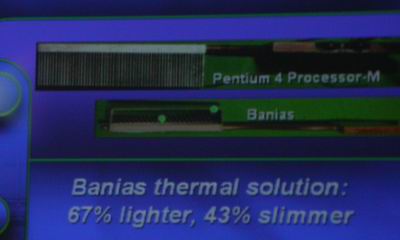
Banias' heat exchanger is noticeably smaller than the Pentium 4-M's
Banias will target the portability segment where battery life, small size and good performance are major selling points. The Pentium 4-M will address the mobility segment or basically the desktop replacement market, indicating that the Pentium 4-M will continue to have a performance advantage over Banias. It is clear that Banias is noticeably faster than the current Pentium III-M processors.
The only benchmark Intel ran on Banias was a MPEG-4 encoding test using DiVX; the settings in Xmpeg weren’t too clear but it seemed to be running at 640x480 or 720x480 at the fastest encoding setting with audio processing disabled. The Banias test platform was consistently getting around 30 fps which was decent but the most impressive part of the demo was its power consumption while running the test – 7W. After the encoding was completed the CPU went back down to using under 1W of power; keeping in mind that Banias is supposed to enable notebooks with an 8 hour battery life, this may just make it happen.
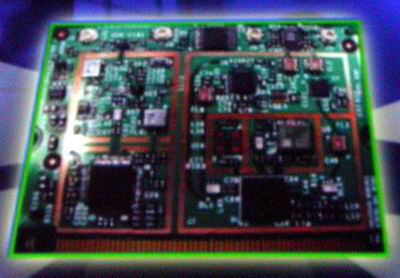
A Banias Motherboard
Intel also introduced a new chipset for Banias in addition to Odem, which was announced at IDF 6 months ago. The new chipset is called Montara-GM and its name indicates that it may be an integrated graphics version of the Odem chipset. Intel also confirmed today that the platforms will have support for both 802.11a and 802.11b; through a combination of software and hardware support, the integrated wireless will be optimized for low power consumption by automatically putting the radio to sleep when not in use.
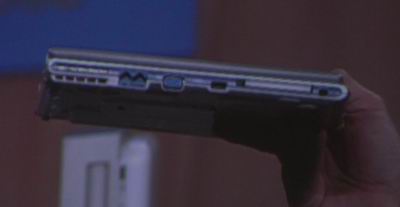
Samsung's Banias notebook

A Banias tablet
Final Words
Today was definitely all about Banias and we hope you enjoyed the coverage;
now it’s back to the show.

